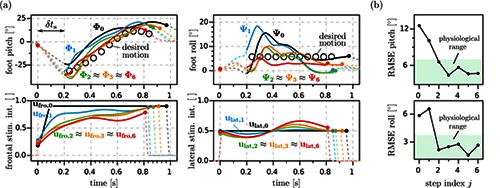Fig 5.

Experimental results from a trial with a chronic drop foot patient.9 (a) The stimulation intensities are adapted from stride to stride in order to generate the desired foot motion during swing phase. Dots mark heel-rise and initial contact of each stride. Starting from conventional high trapezoidal profiles (ufro,0 and ulat,0), the ILC adjusts the frontal and lateral stimulation intensity trajectories from trial to trial and thereby improves the foot pitch and roll angle trajectories (Φi and ψi ) from stride to stride. (b) Root-mean-square errors of the foot pitch and roll (data from same trial) are quickly reduced to the ranges of natural variance found in healthy subjects walking at similar velocities. Reproduced with the permission of IFAC. © IFAC 2015. The original figure was published in,9 and can be found using the Digital Object Identifier (DOI) doi:10.1016/j.ifacol.2015.10.158.
